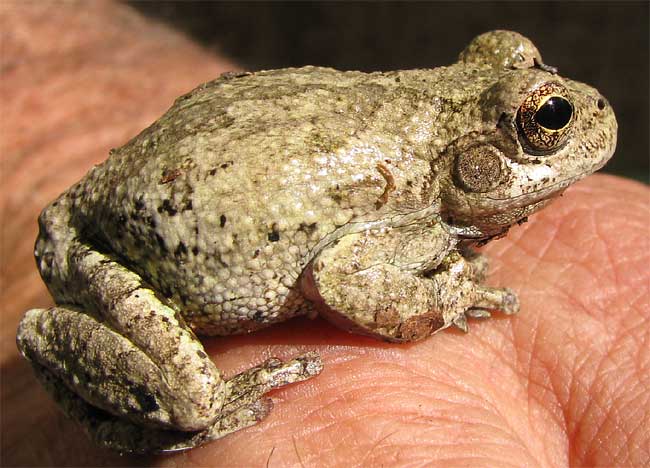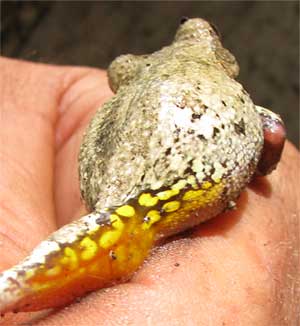Excerpts from Jim Conrad's
Naturalist Newsletter

from the April 6, 2009 Newsletter, issued from the forest near Natchez, Mississippi; elevation ~400ft (120m), ~N31.47°, ~W91.29°:
COPE'S GRAY TREEFROG
During the afternoon cornbread-fixing campfire a leaf seemed to take a jump, so I went to look and it turned out to be a gray treefrog. The name "gray treefrog" isn't capitalized because I'm not sure of the frog's identity. It was just a gray frog, which you see above.
The doubt about the name arises from this sentence in the Audubon field guide: "The two species of Gray Treefrog are identical in appearance, and since their ranges overlap extensively, they cannot be distinguished in the field." So, two identical, gray frog species occur here: the Common Gray Treefrog, HYLA VERSICOLOR, and; Cope's Gray Treefrog, HYLA CHRYSOSCELIS*.
The two species are recognized as separate not only because Cope's calls with a faster trill but, more importantly, it has only half as many chromosomes as the Common Gray. They don't interbreed in Nature.
Actually, my first thought when I approached the somewhat warty frog had been that it was a small toad. However, you can see that the tips of this frog's toes are more rounded than a toad's, plus behind the bulging eyes there are no tumor-like, poison-producing parotoid glands, which toads have.
Treefrog toe-tips are rounded and enlarged because they serve as sticky adhesive pads for climbing trees. Both gray treefrog species typically are found in trees and shrubs in or near permanent water, so maybe our individual was on a hop-about looking for a new home or a mate. One problem with that theory is that the literature assures us that the two species are nocturnal and shouldn't be on the ground on a sunny afternoon, so, who knows?
 When I clicked the shutter during one shot the frog lurched away, not only causing a blur but also revealing bright, yellow-orange spots on the undersurfaces of the frog's back legs, as shown at the right.:
When I clicked the shutter during one shot the frog lurched away, not only causing a blur but also revealing bright, yellow-orange spots on the undersurfaces of the frog's back legs, as shown at the right.:
Why would a nocturnal frog possess such colorful spotting in a place seldom displayed? First, our gray treefrog species obviously are not entirely nocturnal. During daylight wanderings such as our frog was making the yellow spotting serves for "flashing": When the frog leaps to escape a predator, the bright pattern for a moment may surprise or distract the enemy long enough to help the frog get away.
And why would Nature create two identical-looking and -behaving frog species in the same geographical location? Maybe that's best answered by evoking Nature's pure passion for diversity, and Her tendency to experiment in every way imaginable. I suspect that with time the two species either will evolve so that they don't compete in the very same ecological niche, or else one species will extirpate the other.